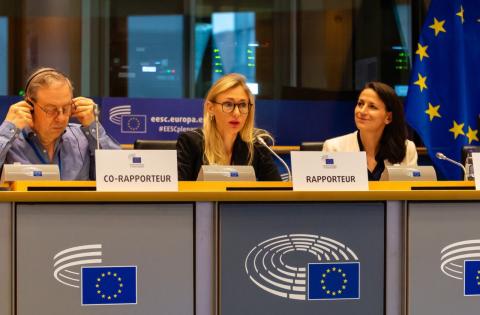European Economic
and Social Committee
Nuclear medicine top priority for beating cancer
The EU must reduce its strategic dependencies in sensitive sectors such as health and critical technologies in order to enable a growing number of patients across Europe to use nuclear medicine to diagnose and treat cancer.
Nuclear medicine and the supply of radioisotopes must be a top priority for the European Union if we want to guarantee equal access to cancer treatment for all patients in Europe.
The EU and the Member States should make sure that funding is available for medical radiological and nuclear technologies. At the same time, they should also step up their cooperation to remove regulatory barriers to the supply of radioisotopes and reduce their dependency on third countries for raw materials.
With this end goal, the EESC opinion entitled Europe's Beating Cancer Plan: Driving forces for the security of medical radioisotopes supply, adopted at the May plenary session, underscores the need to leave no stone unturned in taking action against cancer.
Rapporteurs Alena Mastantuono and Philippe Charry were both firmly of the view that the only way to better secure the supply of radioisotopes in Europe and meet the increasing demand from patients is ‘if we take bold political decisions and if we have sound regulation’.
Nuclear medicine is key to diagnosing and treating cancer
Every year, up to 10 million European patients benefit from nuclear medical imaging when it comes to diagnosing different diseases, such as cancer and heart disease. Radiological and nuclear technologies that use radioisotopes are essential in the fight against cancer at all stages of care: in early detection, diagnosis, treatment and palliative care.
The number of patients benefiting from nuclear medicine is growing, mainly because of scientific breakthroughs. European researchers and businesses have developed some of the latest innovative radionuclide cancer treatments, such as pharmaceuticals targeting endocrine and prostate cancer. In comparison with other treatments, they are localised and often less harmful to the body. Tens of thousands of cancer patients need targeted radionuclide therapy, which is often the only treatment available.
However, before reaching the patient, the supply chain of nuclear medicine is highly complex. It includes the supply of raw materials and their storage, irradiation, processing, logistics and application. Once the radioisotopes are produced, they must be processed, shipped and used within a relatively short period of time, some on the same day, others within a few days, depending on their ‘half-life’. They are highly perishable.
Surprisingly enough, there are a number of administrative barriers that can block their transportation within Europe. This is why the EU needs better cooperation among the Member States to remove the regulatory barriers in the supply chain of radioisotopes in Europe that can hinder cross-border deliveries.
Nuclear medicine must be included in the EU’s Beating Cancer Plan
At the same time, the EU needs to identify dependencies on third countries and provide production incentives in order to ensure better strategic autonomy in the supply of radioisotopes.
Despite being a world leader in the supply of medical radioisotopes, Europe has critical dependencies on the US (about 80%) and Russia (the remaining 20%) for the supply of metallic high-assay low enriched uranium (HALEU) and for the supply of some enriched isotopes for radioisotope production targets.
This represents a challenge to the supply chain, which – needless to say – needs to be carefully monitored and supported by bolstering industrial competitiveness in the sector.
As there are growing needs for radioisotopes, it is important to secure the supply of medical radioisotopes in the long term in order to maintain patients’ access to vital medical procedures and support the development of new cancer treatments.
This is also why the EESC is calling on the Commission to give modern nuclear medicine a more prominent place in Europe’s Beating Cancer Plan and ensure financing of strategic projects of common interest in this area under the EU’s future Multiannual Financial Framework.
